The global polyester microfiber fabric market is set to grow from USD 739.7 million in 2025 to USD 1,033.4 million by 2035, advancing at a 3.4% CAGR. The growth is driven by increasing demand across sectors such as apparel, automotive, and home textiles. These fabrics are popular for their durability, softness, and versatility, making them ideal for both functional and fashion applications. The growing trend toward sustainable fashion is also driving demand, with a rise in the use of recycled polyester fabrics.
Between 2025 and 2030, the polyester microfiber fabric market will grow from USD 739.7 million to USD 874.3 million, with 46% of the total growth occurring in this period. Innovations in textile production technologies, such as advancements in moisture-wicking properties and lightweight designs, will enhance performance, further driving demand. From 2030 to 2035, the polyester microfiber fabric market is expected to expand from USD 874.3 million to USD 1,033.4 million, driven by the growing use of eco-friendly materials and rising consumer demand for high-performance fabrics. The woven polyester microfiber fabric segment leads with a 60% market share, mainly used in apparel, home furnishings, and automotive interiors. The apparel industry dominates, accounting for 35% of the market share, driven by the demand for sportswear, athleisure, and activewear. Key growth regions include China, India, Germany, Brazil, the U.S., the U.K., and Japan, supported by technological advancements and growing consumer interest in sustainable textiles. Top players in the polyester microfiber fabric market include Asahi Kasei Corporation, Cxdqtex, Perfectextile, and Lean Textile, all of which focus on innovation and eco-friendly production methods.
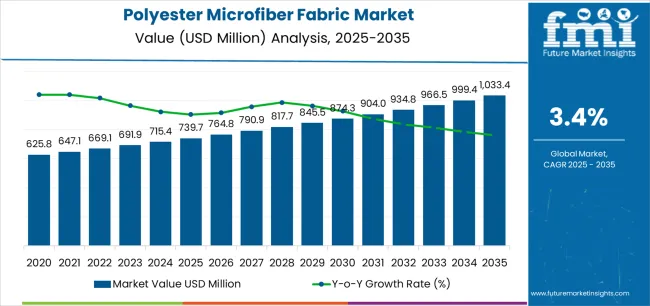
Between 2025 and 2030, the market is expected to grow from USD 739.7 million to USD 874.3 million, adding USD 134.6 million in value. This period will see steady demand from sectors such as apparel and automotive, driven by the growing need for high-performance fabrics. As innovations in textile production techniques allow for more efficient manufacturing of polyester microfibers, the market will continue to see product enhancements and competitive pricing that will support its expansion.
From 2030 to 2035, the market will expand from USD 874.3 million to USD 1,033.4 million, contributing an additional USD 159.1 million. This phase will be characterized by continued growth in emerging markets, where polyester microfiber fabrics are increasingly used in both fashion and home goods. With rising consumer demand for durable, lightweight, and sustainable fabrics, along with advancements in textile recycling technologies, the market will experience further expansion, especially in regions with a strong focus on sustainable textile solutions.
| Metric | Value |
|---|---|
| Market Value (2025) | USD 739.7 million |
| Market Forecast Value (2035) | USD 1,033.4 million |
| Forecast CAGR (2025-2035) | 3.4% |
The polyester microfiber fabric market is driven by several key factors. First, the apparel industry remains the largest consumer, accounting for approximately 35% of the market share. Polyester microfiber fabric is widely used for sportswear, activewear, and fashion apparel due to its lightweight, breathable, and moisture-wicking properties, making it an ideal material for athleisure and outdoor wear. As consumer demand for comfort, durability, and sustainability increases, polyester microfiber is becoming more popular in these segments.
Another major driver is the increasing demand for eco-friendly fabrics. Polyester microfiber fabric is often seen as a more sustainable option compared to conventional fabrics, as it can be made from recycled polyester and is durable and long-lasting. With growing awareness of environmental issues and the sustainability movement in the textile industry, manufacturers are shifting towards fabrics that are both high-performance and environmentally conscious. Furthermore, innovations in manufacturing techniques and the growing trend of sustainable textile production are contributing to the rise in demand for polyester microfiber. In addition to apparel, there is rising use of these fabrics in home furnishings, automotive interiors, and marine applications, further fueling market growth.
The Polyester Microfiber Fabric Market is divided into two primary segments based on classification and application. By classification, the market is split between woven polyester microfiber fabric and knitted polyester microfiber fabric, with the woven segment holding the largest share due to its widespread use in both apparel and home furnishings. The market’s application segments include apparel, home furnishings, automotive and marine interiors, and others, with the apparel industry leading the market, driven by the growing demand for sportswear and activewear. The home furnishings sector is also seeing substantial growth as demand for durable, low-maintenance fabrics rises. Geographically, regions such as China, India, and Germany are seeing the highest market shares, driven by their strong textile industries and robust manufacturing capabilities. These regions are expected to continue leading the market due to the increasing demand for sustainable, high-performance fabrics in various sectors.
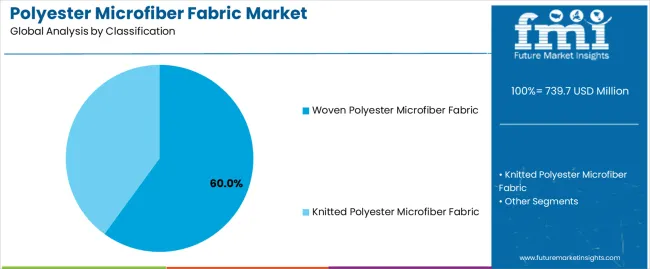
The woven polyester microfiber fabric segment is the dominant classification in the Polyester Microfiber Fabric Market, holding around 60% of the market share. Woven fabrics are known for their superior durability, texture, and finish, which makes them highly versatile for a range of applications. This segment’s leading position is largely driven by the growing demand in the apparel industry, where woven microfiber fabrics are used extensively in sportswear, activewear, and casual clothing. Their lightweight nature, coupled with moisture-wicking and breathability features, make woven polyester microfiber fabrics ideal for athleisure and outdoor wear.
Additionally, woven fabrics are preferred for home furnishings like upholstery, curtains, and bedding due to their ability to maintain their shape and resist wear and tear over time. The global trend towards eco-friendly textiles further fuels the demand for woven microfiber fabric, particularly as it can be produced using recycled polyester and is highly durable, resulting in reduced overall maintenance costs for the consumer. The performance benefits offered by woven polyester microfiber, combined with their sustainability appeal, continue to drive the demand for these fabrics in the global market.
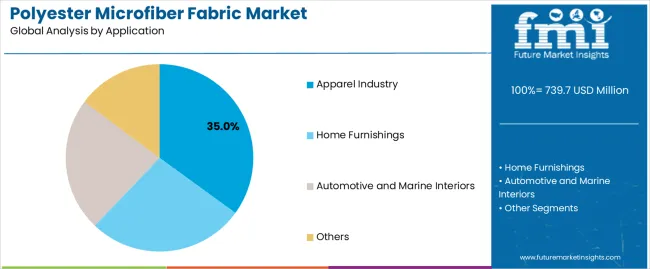
The apparel industry holds the largest share in the Polyester Microfiber Fabric Market, capturing approximately 35% of the market. This dominance can be attributed to the rising demand for activewear, sportswear, and athleisure, which require fabrics that are lightweight, breathable, and moisture-wicking—qualities that polyester microfiber fabric excels at. As consumer preferences shift toward more functional fashion, the need for fabrics that offer comfort, durability, and performance is rising, driving the adoption of polyester microfiber fabrics in the apparel industry.
Furthermore, the increasing popularity of eco-conscious fashion is propelling demand for sustainable textiles, as polyester microfiber fabric can be made from recycled materials and is known for its long-lasting durability, reducing the need for frequent replacements. The athleisure market is a key driver, where consumers are looking for fabric options that support an active lifestyle without compromising on style or comfort. Additionally, the continued growth in online retail and the global fashion industry is expanding the reach of polyester microfiber fabric, making it a preferred choice in a wide array of sportswear, casual wear, and performance-based apparel.
The Polyester Microfiber Fabric Market is driven by increasing demand for high-performance textiles in the apparel and home furnishings industries. Sportswear, activewear, and athleisure are key drivers, with consumers seeking lightweight, breathable, and moisture-wicking fabrics. Additionally, the sustainability trend is fueling growth as polyester microfiber fabrics can be made from recycled polyester, offering an eco-friendly alternative to traditional textiles. However, the market faces challenges, including high production costs and competition from other synthetic fabrics. Despite these constraints, there is a growing focus on eco-friendly solutions and durability, which are pushing manufacturers to innovate and offer sustainable fabrics that meet the demand for long-lasting, high-performance materials. Technological advancements in textile manufacturing are also enhancing the quality and cost-effectiveness of polyester microfiber fabrics, further supporting market growth. As consumer preferences shift towards sustainability and functionality, the demand for polyester microfiber fabrics is expected to continue to rise in various applications, including apparel, home furnishings, and automotive interiors.
What Are the Key Drivers of the Polyester Microfiber Fabric Market?
The Polyester Microfiber Fabric Market is primarily driven by the increasing demand for high-performance textiles in the apparel industry. The growing popularity of sportswear, activewear, and athleisure is increasing the demand for moisture-wicking, lightweight, and breathable fabrics, which polyester microfiber offers in abundance. The rising consumer preference for sustainable textiles is another key driver, as polyester microfiber fabric can be produced from recycled polyester and has a longer lifespan compared to conventional fabrics.
The home furnishings sector is also a significant driver, as consumers increasingly seek durable, easy-to-clean materials for bedding, curtains, and upholstery. The automotive and marine interior segment is expanding due to the durability, stain resistance, and aesthetic appeal of microfiber fabrics used in seat covers, upholstery, and interior trim. Moreover, technological advancements in the textile manufacturing process, leading to better quality control, cost-effectiveness, and customization options, are further driving the market.
What Are the Key Restraints in the Polyester Microfiber Fabric Market?
Despite the growing demand, several challenges hinder the growth of the Polyester Microfiber Fabric Market. One significant restraint is the high production cost associated with high-quality microfiber fabrics. This is especially true for fabrics made from recycled polyester or those designed for premium products like high-end apparel and furnishings. Additionally, although polyester microfiber fabric is seen as a more sustainable option compared to some alternatives, it still involves the use of petrochemical-based materials, which may pose environmental concerns over the long term.
Another restraint is the competition from other synthetic fabrics, which offer similar performance characteristics at lower prices. Moreover, market saturation in mature markets like Europe and North America, where the demand for microfiber fabrics is already strong, could limit further growth in these regions. Finally, the risk of microplastic pollution from synthetic fabrics like polyester microfiber, particularly when washed, has raised concerns among consumers and environmental regulators, which could impact the market's reputation and growth.
What Are the Key Trends in the Polyester Microfiber Fabric Market?
Several key trends are shaping the Polyester Microfiber Fabric Market. Sustainability continues to be a major trend, with growing interest in eco-friendly fabrics. Recycled polyester and biodegradable microfiber fabrics are gaining popularity due to increased consumer awareness about environmental impact. Additionally, innovative textile treatments that improve moisture-wicking properties, stain resistance, and antibacterial features are in high demand, particularly in the apparel and home furnishings industries.
The trend of premiumization is also driving the market, with luxury home goods and high-performance activewear demanding high-quality microfiber fabrics. The automotive and marine industries are increasingly using microfiber fabrics for upholstery due to their durability, comfort, and aesthetic appeal. Moreover, as personalization and customized textile products become more popular, textile manufacturers are developing tailored solutions to meet the specific needs of different sectors, including sportswear, interior design, and automotive applications.
The polyester microfiber fabric market is seeing diverse growth across different regions, driven by the expansion of textile production, sustainability initiatives, and the growing demand for high-performance fabrics. China, India, and Germany are leading markets due to their strong manufacturing bases and robust textile industries. Brazil, the U.S., and Japan also show steady growth, fueled by increasing consumer demand for sustainable materials in apparel, home furnishings, and automotive sectors. These regions are adopting eco-friendly microfiber fabrics, with recycled polyester becoming a key ingredient for sustainable textile production. The growth in the market is further supported by technological advancements, increased focus on green textiles, and the rising popularity of sportswear, athleisure, and functional fabrics across the globe.

| Country | CAGR (%) |
|---|---|
| China | 4.6 |
| India | 4.3 |
| Germany | 3.9 |
| Brazil | 3.6 |
| U.S. | 3.2 |
| U.K. | 2.9 |
| Japan | 2.6 |
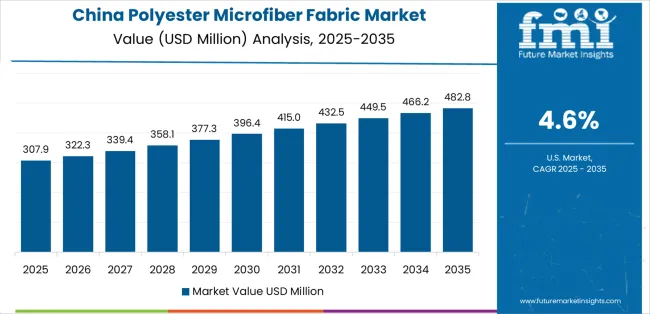
China, with a CAGR of 4.6%, is the largest market for polyester microfiber fabric, driven by its position as the world's largest textile producer and consumer. The country’s rapidly expanding textile manufacturing sector demands high-performance fabrics for various applications, including apparel, home furnishings, and automotive interiors. China’s commitment to sustainability is fueling the demand for eco-friendly fabrics, such as those made from recycled polyester, making microfiber fabrics an attractive solution for green construction. The government’s focus on upgrading manufacturing capabilities and expanding textile exports is also supporting the growth of polyester microfiber fabric in domestic and international markets. Furthermore, the increasing popularity of activewear, athleisure, and functional fashion in China is further boosting demand for polyester microfiber fabrics, which are well-known for their lightweight, moisture-wicking, and breathable properties.
India, with a CAGR of 4.3%, is a key player in the Polyester Microfiber Fabric Market due to its growing textile industry and increasing demand for high-performance fabrics. The rise in urbanization, consumer spending, and the growing middle class are contributing to a surge in demand for eco-friendly textiles. In India, polyester microfiber fabric is increasingly used in sportswear, athleisure, and home furnishings due to its breathability, durability, and lightweight nature. The country’s textile industry is undergoing rapid modernization, with a strong push toward more sustainable manufacturing processes. Additionally, India’s emphasis on expanding exports of eco-friendly textiles is making polyester microfiber fabric a key player in global textile supply chains. With increasing awareness about sustainability and the demand for functional fashion, India is poised to maintain a strong position in the polyester microfiber fabric market.
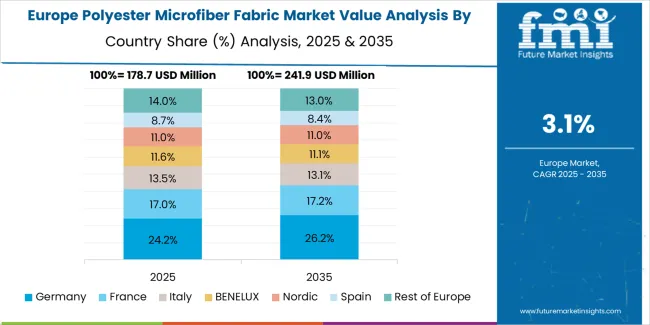
Germany, with a CAGR of 3.9%, continues to see steady growth in the Polyester Microfiber Fabric Market due to its strong focus on sustainable textiles and high-quality manufacturing. As a leader in green construction and eco-friendly manufacturing practices, Germany is increasingly adopting polyester microfiber fabrics made from recycled materials for apparel, automotive interiors, and home furnishings. The growing demand for durable and easy-to-maintain fabrics in upholstery, furnishings, and automotive applications is supporting market growth. Furthermore, Germany’s automotive industry increasingly uses microfiber fabrics for seating and interior trim, given their long-lasting performance and stain resistance. As consumer interest in sustainable living continues to rise, polyester microfiber fabrics are gaining traction as an environmentally friendly and high-performance material for a wide range of industrial applications.
Brazil, with a CAGR of 3.6%, is seeing steady growth in the Polyester Microfiber Fabric Market, driven by its expanding textile and apparel industry. As the country’s infrastructure improves, there is a growing demand for high-performance fabrics in home furnishings, automotive interiors, and sportswear. Brazil's increasing middle-class population is driving demand for affordable yet durable fabrics, particularly for upholstery and automotive interiors. The country’s growing focus on eco-friendly materials and sustainability has fueled the demand for recycled polyester fabrics, further supporting the adoption of polyester microfiber. Brazil's automotive sector has also been a major contributor to the growth of the microfiber fabric market, where demand for stain-resistant and durable materials is increasing. As Brazil continues to develop, both locally and internationally, polyester microfiber fabric is expected to maintain its role as an essential material in various manufacturing applications.
The USA., with a CAGR of 3.2%, is experiencing steady growth in the Polyester Microfiber Fabric Market, driven by demand for high-performance textiles in the apparel industry. Sportswear, athleisure, and activewear are the primary segments pushing demand for lightweight, breathable, and moisture-wicking fabrics. The growing interest in eco-friendly textiles is another key factor, as consumers increasingly prefer sustainable materials like recycled polyester. The U.S. textile industry continues to innovate, focusing on durability and performance, which makes polyester microfiber an ideal material for sportswear, workout clothes, and outdoor gear. Furthermore, the rise of e-commerce has expanded access to high-performance apparel that incorporates polyester microfiber fabrics, pushing further growth in the market. With a focus on green manufacturing and eco-conscious fashion, the U.S. market is set to continue expanding in line with sustainability trends in textile production.
The UK, with a CAGR of 2.9%, shows steady demand for polyester microfiber fabric driven by a growing emphasis on eco-friendly construction materials and sustainable textiles. The demand for high-performance fabrics in apparel and home furnishings continues to rise, with microfiber fabrics being used in upholstery, bedding, and activewear due to their durability and resistance to wear and tear. As in the U.S., the U.K. is seeing a shift toward eco-conscious fashion and sustainable textile practices, which is propelling the use of recycled polyester in microfiber fabrics. The U.K.’s commitment to environmental regulations and reducing carbon footprints in manufacturing aligns well with the demand for more sustainable textile solutions, further driving growth in polyester microfiber fabrics. The increasing popularity of functional fashion, where performance and style intersect, also contributes to the rising adoption of microfiber fabrics in apparel. As the market continues to grow, the U.K. is expected to benefit from ongoing shifts toward sustainability and innovation in the textile sector.
The Polyester Microfiber Fabric Market is highly competitive, with both global and regional players vying for market share. Asahi Kasei Corporation is one of the key players, holding approximately 8% of the market, thanks to its extensive range of high-quality, durable microfiber fabrics. Other significant companies like Cxdqtex, Perfectextile, and Lean Textile focus on innovative product offerings and customization to meet the rising demand for high-performance fabrics in various sectors. These companies are also expanding their sustainable product lines, including eco-friendly microfiber fabrics made from recycled polyester, catering to the growing consumer preference for green textiles.
Regional players like Wujiang Nuode Textile Co., Ltd., Shaoxing Starke Textile Co., Ltd., and Hangzhou K&M Textile Co., Ltd. are gaining traction in local markets by providing cost-effective solutions while maintaining high quality. Strategic partnerships and technological advancements in textile manufacturing have become common strategies among these players to capture a larger market share, particularly in emerging markets. As demand for sustainable fabrics and high-performance textiles increases globally, companies that focus on innovation and environmental responsibility will be better positioned to capture market share and sustain growth.
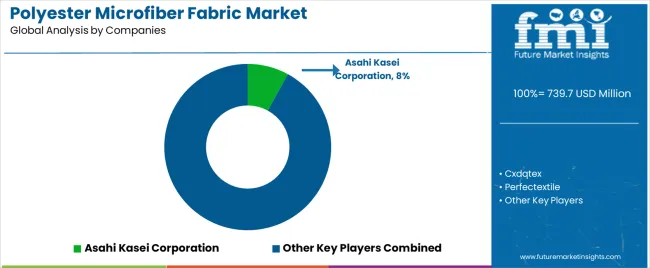
| Items | Details |
|---|---|
| Quantitative Units | USD Million |
| Classification | Woven Polyester Microfiber Fabric, Knitted Polyester Microfiber Fabric |
| Application | Apparel Industry, Home Furnishings, Automotive and Marine Interiors, Others |
| Regions Covered | Asia Pacific, Europe, North America, Latin America, Middle East & Africa |
| Countries Covered | USA, China, India, Japan, South Korea, Germany, Italy, 40+ other countries |
| Key Companies Profiled | Asahi Kasei Corporation, Cxdqtex, Perfectextile, Lean Textile, Wujiang Nuode Textile Co., Ltd., ShaoXing Starke Textile Co., Ltd, Hangzhou K&M Textile Co., Ltd, Jiangsu Textile Research Institute Inc., Wintex Fashion, Shaoxing Keqiao Huile Textile Co., Ltd., Shengzhou YILI Necktie & Garment Co., Ltd, Sikortex |
| Additional Attributes | The market analysis includes dollar sales by classification and application categories. It also covers regional adoption trends across major markets such as China, India, and the USA. The competitive landscape features key manufacturers in the polyester microfiber fabric sector, focusing on innovations in fabric technology and its applications in apparel, home furnishings, and automotive interiors. Trends in consumer demand for microfiber fabrics, as well as the growing focus on sustainability in textile production, are also explored. |
The global polyester microfiber fabric market is estimated to be valued at USD 739.7 million in 2025.
The market size for the polyester microfiber fabric market is projected to reach USD 1,033.4 million by 2035.
The polyester microfiber fabric market is expected to grow at a 3.4% CAGR between 2025 and 2035.
The key product types in polyester microfiber fabric market are woven polyester microfiber fabric and knitted polyester microfiber fabric.
In terms of application, apparel industry segment to command 35.0% share in the polyester microfiber fabric market in 2025.






Our Research Products

The "Full Research Suite" delivers actionable market intel, deep dives on markets or technologies, so clients act faster, cut risk, and unlock growth.

The Leaderboard benchmarks and ranks top vendors, classifying them as Established Leaders, Leading Challengers, or Disruptors & Challengers.

Locates where complements amplify value and substitutes erode it, forecasting net impact by horizon

We deliver granular, decision-grade intel: market sizing, 5-year forecasts, pricing, adoption, usage, revenue, and operational KPIs—plus competitor tracking, regulation, and value chains—across 60 countries broadly.

Spot the shifts before they hit your P&L. We track inflection points, adoption curves, pricing moves, and ecosystem plays to show where demand is heading, why it is changing, and what to do next across high-growth markets and disruptive tech

Real-time reads of user behavior. We track shifting priorities, perceptions of today’s and next-gen services, and provider experience, then pace how fast tech moves from trial to adoption, blending buyer, consumer, and channel inputs with social signals (#WhySwitch, #UX).

Partner with our analyst team to build a custom report designed around your business priorities. From analysing market trends to assessing competitors or crafting bespoke datasets, we tailor insights to your needs.
Supplier Intelligence
Discovery & Profiling
Capacity & Footprint
Performance & Risk
Compliance & Governance
Commercial Readiness
Who Supplies Whom
Scorecards & Shortlists
Playbooks & Docs
Category Intelligence
Definition & Scope
Demand & Use Cases
Cost Drivers
Market Structure
Supply Chain Map
Trade & Policy
Operating Norms
Deliverables
Buyer Intelligence
Account Basics
Spend & Scope
Procurement Model
Vendor Requirements
Terms & Policies
Entry Strategy
Pain Points & Triggers
Outputs
Pricing Analysis
Benchmarks
Trends
Should-Cost
Indexation
Landed Cost
Commercial Terms
Deliverables
Brand Analysis
Positioning & Value Prop
Share & Presence
Customer Evidence
Go-to-Market
Digital & Reputation
Compliance & Trust
KPIs & Gaps
Outputs
Full Research Suite comprises of:
Market outlook & trends analysis
Interviews & case studies
Strategic recommendations
Vendor profiles & capabilities analysis
5-year forecasts
8 regions and 60+ country-level data splits
Market segment data splits
12 months of continuous data updates
DELIVERED AS:
PDF EXCEL ONLINE
Polyester Shrink Film Market Size and Share Forecast Outlook 2025 to 2035
Polyester Polyol Market Size and Share Forecast Outlook 2025 to 2035
Polyester Hot Melt Adhesives Market Size and Share Forecast Outlook 2025 to 2035
Polyester Straps Market Size and Share Forecast Outlook 2025 to 2035
Polyester Fiber Market Size and Share Forecast Outlook 2025 to 2035
Polyester Labels Market – Growth & Demand 2025 to 2035
Polyester Resin Dispersion Market Analysis & Forecast by Viscosity Type, Process, End-Use Industry and Region through 2025 to 2035
Industry Share Analysis for Polyester Straps Companies
Spun Polyester Fabric Market Size and Share Forecast Outlook 2025 to 2035
Embossed Polyester Fabric Market Size and Share Forecast Outlook 2025 to 2035
Nonwoven Polyester Fabric Market Growth – Trends & Forecast 2025 to 2035
Saturated Polyester Resin Market Forecast Outlook 2025 to 2035
Demand for Polyester Shrink Film in UK Size and Share Forecast Outlook 2025 to 2035
Metallised Polyester Films Market Size and Share Forecast Outlook 2025 to 2035
Biodegradable Polyester Fiber Market Forecast and Outlook 2025 to 2035
High-Strength Polyester Thread Market Size and Share Forecast Outlook 2025 to 2035
Titanium Catalyst for Polyester Market Size and Share Forecast Outlook 2025 to 2035
Microfiber Cleaning Cloth Market Size and Share Forecast Outlook 2025 to 2035
The Microfiber Synthetic Leather Market is segmented by material, application, and end-use from 2025 to 2035
Fabric Spreading Machine Market Forecast Outlook 2025 to 2035

Thank you!
You will receive an email from our Business Development Manager. Please be sure to check your SPAM/JUNK folder too.
Chat With
MaRIA